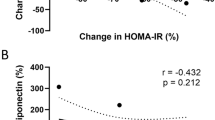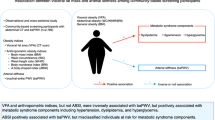Abstract
Objectives:
Adiponectin is an adipocyte-derived collagen-like protein, highly specific to adipose tissue and may represent an important link between obesity and atherosclerosis. The present study was designed to investigate a possible association between serum adiponectin levels and early vascular changes in obese patients as determined by intima media thickness (IMT) and arterial pulse-wave contour analysis.
Design:
Obese subjects (n=47) were evaluated for arterial structure and function, metabolic parameters and serum adiponectin levels.
Measurements:
IMT was measured by ultrasound. Arterial elasticity was evaluated using pulse-wave contour analysis. Insulin resistance was assessed by homeostasis model assessment (HOMA-IR).
Results:
Adiponectin was significantly, inversely associated with mean IMT (r=−0.369, P=0.011) and significantly positively associated with large artery elasticity index (LAEI) (r=0.467, P=0.001) as well as small artery elasticity index (SAEI) (r=0.462, P=0.001). In separate multivariate models, adiponectin remained significantly associated with mean IMT, LAEI and SAEI even after adjustment for cardiovascular confounders. Among metabolic parameters, adiponectin was significantly positively associated with HDL cholesterol and inversely associated with triglycerides. Adiponectin was significantly inversely associated with fasting insulin and HOMA-IR. In addition, a marginally inverse association between adiponectin and ALT was observed.
Conclusions:
In this study, serum adiponectin levels were significantly associated with indices of subclinical atherosclerosis, such as IMT and arterial compliance in obese patients. This association was independent of traditional cardiovascular risk factors.
This is a preview of subscription content, access via your institution
Access options
Subscribe to this journal
Receive 12 print issues and online access
$259.00 per year
only $21.58 per issue
Buy this article
- Purchase on Springer Link
- Instant access to full article PDF
Prices may be subject to local taxes which are calculated during checkout

Similar content being viewed by others
References
Stevens J, Cai J, Evenson KR, Thomas R . Fitness and fatness as predictors of mortality from all causes and from cardiovascular disease in men and women in the lipid research clinics study. Am J Epidemiol 2002; 156: 832–841.
Shinozaki K, Hattori Y, Suzuki M, Hara Y, Kanazawa A, Takaki H et al. Insulin resistance as an independent risk factor for carotid artery wall intima media thickening in vasospastic angina. Arterioscler Thromb Vasc Biol 1997; 17: 3302–3310.
Bonora E, Formentini G, Calcaterra F, Lombardi S, Marini F, Zenari L et al. HOMA-estimated insulin resistance is an independent predictor of cardiovascular disease in type 2 diabetic subjects: prospective data from the Verona Diabetes Complications Study. Diabetes Care 2002; 25: 1135–1141.
Montagnani M, Quon MJ . Insulin action in vascular endothelium: potential mechanisms linking insulin resistance with hypertension. Diabetes Obes Metab 2000; 2: 285–292.
Nickenig G, Roling J, Strehlow K, Schnabel P, Bohm M . Insulin induces upregulation of vascular AT1 receptor gene expression by post transcriptional mechanisms. Circulation 1998; 98: 2453–2460.
Rizzoni D, Porteri E, Guelfi D, Muiesan ML, Valentini U, Cimino A et al. Structural alterations in subcutaneous small arteries of normotensive and hypertensive patients with non-insulin-dependent diabetes mellitus. Circulation 2001; 103: 1238–1244.
Ukkola O, Santaniemi M . Adiponectin: a link between excess adiposity and associated comorbidities? J Mol Med 2002; 80: 696–702.
Störk S, Bots ML, Angerer P, Schacky C, Grobbee DE, Angermann CE et al. Low levels of adiponectin predict worsening of arterial morphology and function. Atherosclerosis 2007; 194: e147–e153.
Schulze MB, Shai I, Rimm EB, Li T, Rifai N, Hu FB . Adiponectin and future coronary heart disease events among men with type 2 diabetes. Diabetes 2005; 54: 534–539.
Chen MP, Tsai JC, Chung FM, Yang SS, Hsing LL, Shin SJ et al. Hypoadiponectinemia is associated with ischemic cerebrovascular disease. Arterioscler Thromb Vasc Biol 2005; 25: 821–826.
Salonen JT, Salonen R . Ultrasonographically assessed carotid morphology and the risk of coronary heart disease. Arterioscler Thromb 1991; 11: 1245–1249.
O'Leary DH, Polak JF, Kronmal RA, Manolio TA, Burke GL, Wolfson Jr SK . Carotid-artery intima and media thickness as a risk factor for myocardial infarction and stroke in older adults. N Engl J Med 1999; 340: 14–22.
Cohn JN, Duprez DA, Grandits GA . Arterial elasticity as part of a comprehensive assessment of cardiovascular risk and drug treatment. Hypertension 2005; 46: 217–220.
Overweight, obesity, and health risk. National Task Force on the prevention and treatment of obesity. Arch Intern Med 2000; 160: 898–904.
Expert Panel on Detection, Evaluation and Treatment of High Blood Cholesterol in Adults. Executive summary of the Third Report of the National Cholesterol education program (NCEP) expert panel on detection, evaluation and treatment of high blood cholesterol in adults. JAMA 2001; 285: 2486–2497.
Matthews DR, Hosker JP, Rudenski AS, Naylor BA, Treacher DF, Turmer RC . Homeostasis model assessment: insulin resistance and β-cell function from fasting plasma glucose and insulin concentrations in man. Diabetologia 1985; 28: 412–419.
Wendelhag I, Gustavsson T, Suurkula M, Berglund G, Wikstrand J . Ultrasound measurement of wall thickness in the carotid artery. Fundamental principles and description of a computerized image analyzing system. Clin Physiol 1991; 11: 565–577.
Shargorodsky M, Fleed A, Boas M, Gavish D, Zimlichman R . The effect of rapid weight loss induced by laparoscopic adjustable gastric banding on arterial stiffness, metabolic and inflammatory parameters in patients with morbid obesity. Int J Obesity 2006; 30: 632–1636.
Mahmud A, Felly J . Adiponectin and arterial stiffness. Am J Hypertens 2005; 18: 1543–1548.
Iglseder B, Mackevics V, Stadlmayer A, Tasch G, Ladurner G, Paulweber B . Plasma adiponectin levels and sonographic phenotypes of subclinical carotid artery atherosclerosis: data from the SAPHIR Study. Stroke 2005; 36: 2577–2582.
Lorenz MW, von Kegler S, Steinmetz H, Markus HS, Sitzer M . Carotid intima-media thickening indicates a higher vascular risk across a wide age range: prospective data from the Carotid Atherosclerosis Progression Study (CAPS). Stroke 2006; 37: 87–92.
Salonen JT, Salonen R . Ultrasound B-mode imaging in observational studies of atherosclerotic progression. Circulation 1993; 87: II56–II65.
van Popele NM, Grobbee DE, Bots ML, Asmar R, Topouchian J, Reneman RS et al. Association between arterial stiffness and atherosclerosis: the Rotterdam Study. Stroke 2001; 32: 454–460.
Laurent S, Boutouyrie P, Asmar R, Gautier I, Laloux B, Guize L et al. Aortic stiffness is an independent predictor of all-cause and cardiovascular mortality in hypertensive patients. Hypertension 2001; 37: 1236–1241.
Gilani M, Kaiser DR, Bratteli CW, Alinder C, Rajala S, Bank AJ et al. Role of nitric oxide deficiency and its detection as a risk factor in prehypertension. JASH 2007; 1: 45–55.
Ouchi N, Kihara S, Arita Y, Maeda K, Kuriyama H, Okamoto Y et al. Novel modulator for endothelial adhesion molecules: adipocyte-derived plasma protein adiponectin. Circulation 1999; 100: 2473–2476.
Ouchi N, Ohishi M, Kihara S, Funahashi T, Nakamura T, Nagaretani H et al. Association of hypoadiponectinemia with impaired vasoreactivity. Hypertension 2006; 42: 231–234.
Matsuda M, Shimomura I, Sata M, Arita Y, Nishida M, Maeda N et al. Role of adiponectin in preventing vascular stenosis: the missing link of adipo-vascular axis. J Biol Chem 2002; 277: 37487–37491.
Bonora E, Kiechl S, Oberhollenzer F, Egger G, Bonadonna RC, Muggeo M et al. Impaired glucose tolerance, type II diabetes mellitus and carotid atherosclerosis: prospective results from Bruneck study. Diabetologia 2000; 43: 156–164.
Rajala U, Laakso M, Päivänsalo M, Pelkonen O, Suramo I, Keinänen-Kiukaaniemi S . Low insulin sensitivity measured by both quantitative insulin sensitivity check index and homeostasis model assessment method as a risk factor of increased intima-media thickness of the carotid artery. J Clin Endocrinol Metab 2002; 87: 5092–5097.
Rantala AO, Päivänsalo M, Kauma H, Lilja M, Savolainen MJ, Reunanen A et al. Hyperinsulinemia and carotid atherosclerosis in hypertensive and control subjects. Diabetes Care 1998; 21: 1188–1193.
Hedblad B, Nilsson P, Janzon L, Berglund G . Relation between insulin resistance and carotid intima-media thickness and stenosis in non-diabetic subjects. Results from a cross-sectional study in Malmö, Sweden. Diabet Med 2000; 17: 299–307.
Larsson H, Berglund G, Ahrén B . Insulin sensitivity, insulin secretion, and glucose tolerance versus intima-media thickness in nondiabetic postmenopausal women. J Clin Endocrinol Metabol 2003; 88: 4791–4797.
Kim SG, Kim HY, Seo JA, Lee KW, Oh HJ, Kim NH et al. Relationship between serum adiponectin concentration, pulse wave velocity and nonalcoholic fatty liver disease. Europ J Endocrinol 2005; 152: 225–231.
Author information
Authors and Affiliations
Corresponding author
Rights and permissions
About this article
Cite this article
Shargorodsky, M., Boaz, M., Goldberg, Y. et al. Adiponectin and vascular properties in obese patients: is it a novel biomarker of early atherosclerosis?. Int J Obes 33, 553–558 (2009). https://doi.org/10.1038/ijo.2009.37
Received:
Revised:
Accepted:
Published:
Issue Date:
DOI: https://doi.org/10.1038/ijo.2009.37
Keywords
This article is cited by
-
Double blind control trial of vitamin D fortified milk on the expression of lncRNAs and adiponectin for patients with metabolic syndrome
Diabetology & Metabolic Syndrome (2023)
-
Adipokines, adiposity, and atherosclerosis
Cellular and Molecular Life Sciences (2022)
-
Adiponectin in eutrophic and obese children as a biomarker to predict metabolic syndrome and each of its components
BMC Public Health (2013)
-
Improvement in insulin resistance and favourable changes in plasma inflammatory adipokines after weight loss associated with two months’ consumption of a combination of bioactive food ingredients in overweight subjects
Endocrine (2013)
-
Inflammatory markers and metabolic syndrome among adolescents
European Journal of Clinical Nutrition (2012)



